

The Three Gorges Reservoir in central China’s Hubei province has served as a strong guarantee of safety for flood control efforts in coping with the frequent and massive regional floods with high flood peaks in the main streams of the middle and lower reaches of the Yangtze River since the beginning of the flood season in last June.
From July 2 to August 20, the Three Gorges Reservoir experienced a total of five heavy floods. On August 20, the inbound water flow reached this year’s record high of 75,000 cubic meters per second as the peak floodwater of Yangtze River’s fifth flood of the year arrived at the Three Gorges Dam.
In the face of the greatest flood peak since the Three Gorges Reservoir was built in 2003, 11 floodgates of the Three Gorges Dam were opened to discharge the floodwater at a rate of 49,200 cubic meters per second.
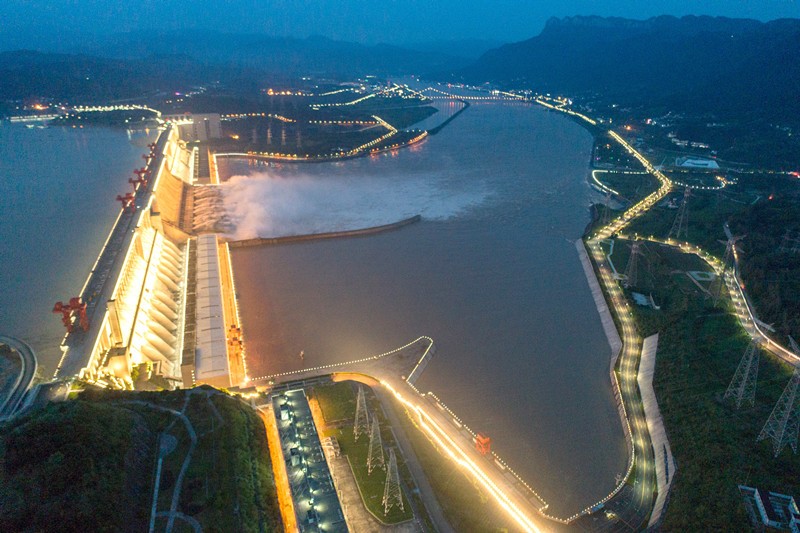
Photo taken on August 19 shows the Three Gorges Dam discharging floodwater through 10 of its spillway holes. On the night of August 19, the Three Gorges project opened 11 deep spillway holes to discharge floodwater. (Photo by Wang Gang/People’s Daily Online)
The Ministry of Water Resources (MWR) has held 40 intensive conferences and consultations since July, giving 57 orders for withholding and discharging floodwater.
“Since the water level of the Three Gorges Reservoir is allowed to be kept between 145 meters and 175 meters, it has 22.15 billion cubic meters of storage capacity for flood control, which can have a direct influence on the flood control in the Jingjiang section and the Chenglingji section of the Yangtze River,” said Chen Guiya, deputy chief engineer of the Changjiang Water Resources Commission of the MWR.
“Relieving pressure” on flood prevention in the middle and lower reaches of the Yangtze River is one of the most important tasks of the Three Gorges Reservoir, Chen noted, explaining that experts would always calculate relevant volumes and rates of floodwater over and over again before putting forward a plan for flood control.
Since the beginning of this year’s flood season, the Three Gorges Reservoir has intercepted a total of 18.2 billion cubic meters of potential floodwater, kept the outbound flow of water at around 42,000 cubic meters per second, and recorded a maximum peak clipping ratio (the ratio by which flood is intercepted) of 33 percent.
The middle and lower reaches of the Yangtze River are the major areas for flood control in the river. Surrounded by water and mountains, the Three Gorges Reservoir is not only the core of the cascade reservoirs of the upper reaches, but the master key to the control of the inflow of water to the middle and lower reaches of the longest river in China.
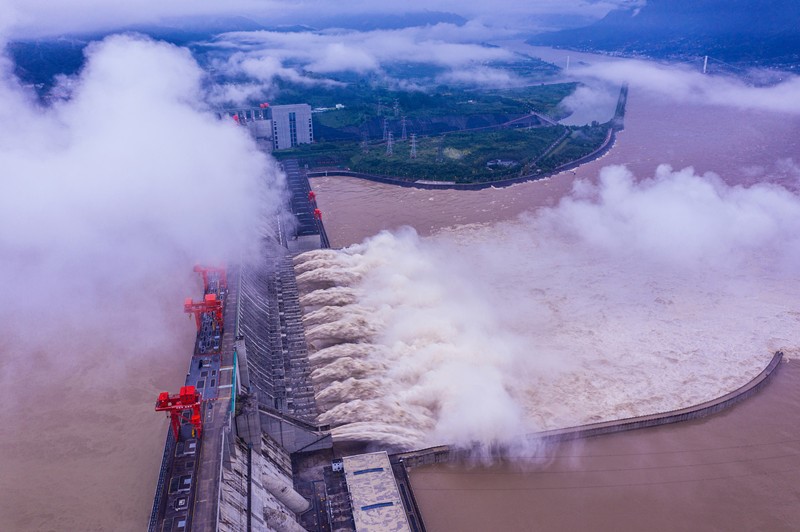
The Three Gorges project opens 11 deep spillway holes to discharge floodwater, August 20. (Photo by Zheng Kun/People’s Daily Online)
Reservoirs have been used for flood control in 87 operations in Hunan province, 18 operations in Hubei province, and over 40 operations in Jiangxi province.
Meanwhile, over 30 reservoirs of the middle and upper reaches of Yangtze River with the Three Gorges Reservoir as the core have accumulatively withheld more than 30 billion cubic meters of floodwater in coordination with various flood storage areas.
“The successful operation of the Three Gorges Reservoir in flood control cannot be achieved without coordination with various areas,” Chen said.
It has been the close coordination among various parts of the country, including southwest China’s Chongqing municipality, Hubei province, Hunan province, as well as east China’s Anhui province and Jiangxi province, that ensured the smooth implementation of orders and formed a pattern featuring coordinated operation of reservoirs of upper and middle reaches and the main stream and branches of the Yangtze River for flood control, Chen noted.
“We hold consultations three times a day, and put forward four to five plans each time,” disclosed Chu Minghua, director of the No. 1 flood control office of the Department of Flood and Drought Disaster Prevention of the MWR, explaining that in order to report the situation precisely, get accurate data, and find the best solution, they often hold consultations and video conferences promptly after noticing signs of flooding no matter how late it is at night.
Scientific regulation of reservoirs is based on accurate predictions about the situation.
With more than 30,000 rainfall monitoring stations collecting data automatically and such “powerful weapons” as meteorological satellites, high precision GPS, and 5G network performing their functions, China has been able to keep its accuracy of forecast for water volume under several cubic meters and water level within centimeters, according to an executive of the hydrographic office of the Changjiang Water Resources Commission of the MWR.
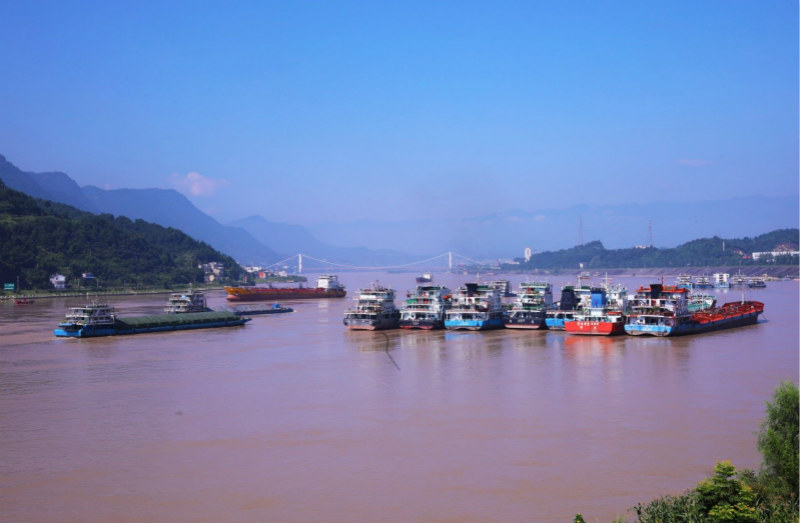
The Three Gorges project opens 11 deep spillway holes to discharge floodwater, August 20. (Photo by Zheng Kun/People’s Daily Online)
At present, the dikes located around 3,900 kilometers from the trunk stream of the middle and lower reaches of the Yangtze River are getting consolidated continuously.
Coordinated operation has enabled the Three Gorges Reservoir and the reservoirs at the middle and upper reaches of the Yangtze River to guarantee a flood control capacity of about 57.4 billion cubic meters.
The pressure on flood control in Yangtze River can be further relieved with the roles of the flood diversion area of Yangtze River’s Jiangjiang section and the Honghu Lake flood diversion area in Hubei, as well as the flood storage and embankment projects of Dongting Lake and Poyang Lake located on both sides of the river.
“The flood prevention system of Yangtze River is getting increasingly perfect with each passing day. The combination of multiple flood prevention measures is like a multi-layered safety net for the river,” Chen noted.
“For instance, the Three Gorges Reservoir can control over 90 percent of the inflow of water to the Jingjiang section, thus raising the flood prevention level to once in a century. It can play an even greater role in flood control in coordination with flood storage areas,” added Chen.
August is a critical period for China’s flood prevention efforts. Fortunately, the country has built the high-standard Three Gorges Dam, which can withstand massive flood.
With flood discharge facilities including 23 deep spillway holes, 22 surface spillway holes, and 8 bottom holes for discharging sediment, the Three Gorges Reservoir can realize balance between inflow and outflow of water in a short time.
In addition, there are 111 large reservoirs located upstream of the Three Gorges Reservoir. They can share the pressure on the reservoir when necessary.
Flood control is like a major test of a country’s flood prevention systems. The key to score a victory in the test is to improve weak links.
According to Chen, relevant departments and regions in China should intensify efforts to boost the construction of flood storage areas, reinforce embankments, and set up flood-diversion sluices so as to improve efficiency in flood diversion and better support the operation of the flood prevention system of Yangtze River.
Besides, planning and management for local protective embankments in bottomlands of the middle and lower reaches of the Yangtze River and the areas near the Dongting Lake and Poyang Lake, so that they can play a part in flood storage while development in these areas can still proceed in an orderly manner, Chen noted.

 Award-winning photos show poverty reduction achievements in NE China's Jilin province
Award-winning photos show poverty reduction achievements in NE China's Jilin province People dance to greet advent of New Year in Ameiqituo Town, Guizhou
People dance to greet advent of New Year in Ameiqituo Town, Guizhou Fire brigade in Shanghai holds group wedding
Fire brigade in Shanghai holds group wedding Tourists enjoy ice sculptures in Datan Town, north China
Tourists enjoy ice sculptures in Datan Town, north China Sunset scenery of Dayan Pagoda in Xi'an
Sunset scenery of Dayan Pagoda in Xi'an Tourists have fun at scenic spot in Nanlong Town, NW China
Tourists have fun at scenic spot in Nanlong Town, NW China Harbin attracts tourists by making best use of ice in winter
Harbin attracts tourists by making best use of ice in winter In pics: FIS Alpine Ski Women's World Cup Slalom
In pics: FIS Alpine Ski Women's World Cup Slalom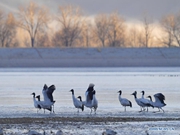 Black-necked cranes rest at reservoir in Lhunzhub County, Lhasa
Black-necked cranes rest at reservoir in Lhunzhub County, Lhasa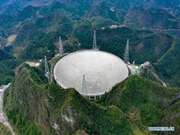 China's FAST telescope will be available to foreign scientists in April
China's FAST telescope will be available to foreign scientists in April